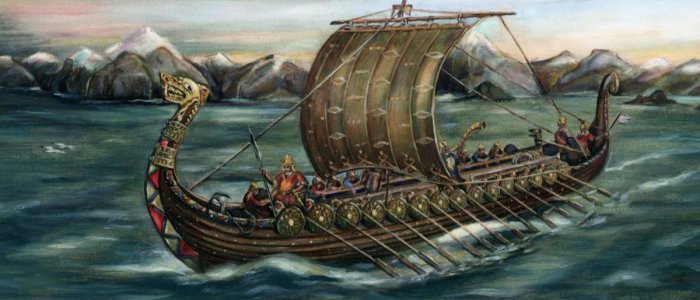Why Were Viking Raids So Successful?
Ellen Lloyd - AncientPages.com - At the height of their success Vikings covered the British Isles, modern Europe, Russia, the Middle East, North India, China and North America. There is no doubt that the Vikings were skilled warriors, but their fighting ability was not the main reason why they managed to conquer and plunder so many countries and places.
So, why were the Viking raids so successful?
Now, we have to remember that a Viking raid nearly always came as a total surprise. The Vikings were very skilled navigators with excellent knowledge of the coasts of Europe and they planned their raids very carefully.
There was no room for mistakes. Although mistakes did sometimes take place, like for example when the famous Viking Bjorn Ironside captured Luna instead of ancient Rome as planned.
Vikings had very sophisticated ships, called longships. The strength, maneuverability and speed of the longship gave the Vikings vital key advantages. The choice between sail and oars allowed the Norse warriors to row until land was sighted and then proceed silently, under sail, during the night or in the early morning. This gave their attacks the element of surprise.
The shallow draught allowed them to land virtually anywhere on a sea shore or deeply inland on a river. This meant they could operate almost anywhere they chose.
Another important aspect of course is that Vikings were in fact great warriors who were trained in various fighting techniques from early age. Many successful Norse warriors spent their youth in competitive fighting games in preparation for the life of a warrior.
They had good armor, shields and a plethora of weapons, including double-edged swords. Your prestige as a man was manifest in the fine craftsmanship of your weapons which were so much part of you, that they had personal names like “leg-biter” or “bone-crusher” or “golden-hilt”.
Written by - Ellen Lloyd - AncientPages.com
Copyright © AncientPages.com All rights reserved. This material may not be published, broadcast, rewritten or redistributed in whole or part without the express written permission of AncientPages.com
More From Ancient Pages
-
 Pre-Clovis, Paisley Caves: Archaeologists Identified The Earliest Population Of North America
Archaeology | Jul 16, 2020
Pre-Clovis, Paisley Caves: Archaeologists Identified The Earliest Population Of North America
Archaeology | Jul 16, 2020 -
 ‘Impossible’ Ancient Egyptian Visit Troubles Historians
Ancient Mysteries | Feb 11, 2021
‘Impossible’ Ancient Egyptian Visit Troubles Historians
Ancient Mysteries | Feb 11, 2021 -
 Magnificent Ancient Treasure Discovered In Crimea – But Who Does It Belong To?
Archaeology | Dec 10, 2024
Magnificent Ancient Treasure Discovered In Crimea – But Who Does It Belong To?
Archaeology | Dec 10, 2024 -
 Two Men Sentenced To Prison For Vandalism Of 4,000-Year-Old Petroglyphs In Nevada
Archaeology | Nov 12, 2022
Two Men Sentenced To Prison For Vandalism Of 4,000-Year-Old Petroglyphs In Nevada
Archaeology | Nov 12, 2022 -
 Clay Cylinders With Oldest Known Alphabet Unearthed In Ancient Syrian City Of Umm-el Marra
Archaeology | Nov 21, 2024
Clay Cylinders With Oldest Known Alphabet Unearthed In Ancient Syrian City Of Umm-el Marra
Archaeology | Nov 21, 2024 -
 Gefjon: Norse Fertility Goddess Who Knew Humans’ Fates, And Plowed Away Part Of Sweden To Give It To Denmark
Featured Stories | Nov 22, 2019
Gefjon: Norse Fertility Goddess Who Knew Humans’ Fates, And Plowed Away Part Of Sweden To Give It To Denmark
Featured Stories | Nov 22, 2019 -
 Edzna: Ancient Maya City With Sophisticated Underground System Of Canals To Control Unpredictable Floods
Featured Stories | Jun 2, 2021
Edzna: Ancient Maya City With Sophisticated Underground System Of Canals To Control Unpredictable Floods
Featured Stories | Jun 2, 2021 -
 Unknown 2,000-Year-Old Settlement Hidden In The Polish Tuchola Forest Revealed By LIDAR
Archaeology | Feb 18, 2019
Unknown 2,000-Year-Old Settlement Hidden In The Polish Tuchola Forest Revealed By LIDAR
Archaeology | Feb 18, 2019 -
 Second Gate Of Bazira And Unique Artifacts Discovered In The Ancient City Of Alexander The Great
Archaeology | Mar 29, 2022
Second Gate Of Bazira And Unique Artifacts Discovered In The Ancient City Of Alexander The Great
Archaeology | Mar 29, 2022 -
 Amazing Archaeological Discovery In Washington Confirms Thousand-Year-Old Legend
Featured Stories | Jul 7, 2024
Amazing Archaeological Discovery In Washington Confirms Thousand-Year-Old Legend
Featured Stories | Jul 7, 2024 -
 Fascinating Discovery – First Female Viking Grave Discovered In Swedish Mountains
Archaeology | Aug 20, 2022
Fascinating Discovery – First Female Viking Grave Discovered In Swedish Mountains
Archaeology | Aug 20, 2022 -
 11,000-Year-Old Human Remains Found At Heaning Wood Bone Cave In Britain
Archaeology | Jan 25, 2023
11,000-Year-Old Human Remains Found At Heaning Wood Bone Cave In Britain
Archaeology | Jan 25, 2023 -
 Mysterious Nine Worlds Of Yggdrasil – The Sacred Tree Of Life In Norse Mythology
Featured Stories | Mar 8, 2017
Mysterious Nine Worlds Of Yggdrasil – The Sacred Tree Of Life In Norse Mythology
Featured Stories | Mar 8, 2017 -
 Earth’s First Animals Had Particular Taste In Real Estate
Evolution | May 10, 2023
Earth’s First Animals Had Particular Taste In Real Estate
Evolution | May 10, 2023 -
 Evidence Oldest Bone Spear Point In The Americas Is 13,900 Years Old
Archaeology | Feb 3, 2023
Evidence Oldest Bone Spear Point In The Americas Is 13,900 Years Old
Archaeology | Feb 3, 2023 -
 Truly Bizarre And Most Fearsome Ancient Helmets Ever Seen
Artifacts | Sep 1, 2016
Truly Bizarre And Most Fearsome Ancient Helmets Ever Seen
Artifacts | Sep 1, 2016 -
 380-Million-Year-Old Heart – The Oldest Ever Found Sheds New Light On Evolution Of Human Bodies
Archaeology | Sep 16, 2022
380-Million-Year-Old Heart – The Oldest Ever Found Sheds New Light On Evolution Of Human Bodies
Archaeology | Sep 16, 2022 -
 Perfectly Preserved Roman Tombs Discovered Near City Of Capua Where Spartacus Trained As Gladiator
Archaeology | Jan 7, 2021
Perfectly Preserved Roman Tombs Discovered Near City Of Capua Where Spartacus Trained As Gladiator
Archaeology | Jan 7, 2021 -
 Fremont Indians: Unique 2,500-Year-Old Forgotten Culture Of North America
Artifacts | Jan 26, 2018
Fremont Indians: Unique 2,500-Year-Old Forgotten Culture Of North America
Artifacts | Jan 26, 2018 -
 Shining Ones And Magic In Ireland – Secret Wisdom Of The Gods
Celtic Mythology | May 9, 2014
Shining Ones And Magic In Ireland – Secret Wisdom Of The Gods
Celtic Mythology | May 9, 2014

